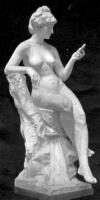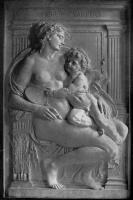V is for Vanity
Statue of Vanity.
Statues of Vanity in Victorian and Edwardian times are inevitably female. Vanity is typically in the form of a beautiful girl, nude or semi-nude, admiring herself in a mirror. The example above is typical Edwardian statue of Vanity, here seated on some rock and tree-stump, gazing into the small mirror held in one hand, her relaxed position suggesting that she is prepared to spend some time admiring herself, and her complacent expression indicating her satisfaction with what she sees. She is young, with an ideal figure, rather more curvy than many Edwardian girls, but with the typical hairstyle of the era.
Here is a semi-nude example, wearing a light off-the hip garment, standing holding her mirror at arms length, the better to see as much of herself as possible. The unconscious pose of her right hand is charming. This figure of Vanity, of similar date to our first example, has a more typically Edwardian physique, with a more slender, almost boyish figure, small-breasted and with a little more musculature to shoulder and upper arm.
Love and Vanity.
The plaque shown above is entitled Amor et Vanitas, Love and Vanity, the combination being a young Eros clasping his plump arms round the body of his mother, thus emblematic of [Motherly] Love. She gazes on the infant, her mirror resting unlooked at in the crook of her free arm. The pose is a good one, with the body facing towards the viewer, head and legs angled to the right, one knee raised to accommodate Eros. This is a fairly unusual rendering of Vanity, by the sculptor Charles Doman. (If you like Eros statues, see this page for the Piccadilly Eros.)
Our final example, below, returns to a single nude young girl, standing and stretching in self-conscious pride in herself, the work of the important sculptor Gilbert Bayes. The title is written on the rock on which she stands, and without this, and no tell-tale mirror, she could have been given half a dozen other allegorical titles.
Back to Allegorical sculpture - U // Onward to Allegorical sculpture - W // Full Alphabet of Allegorical Sculpture
Sculpture in England // Sculptors
Visits to this page from 11 Feb 2016: 4,694



